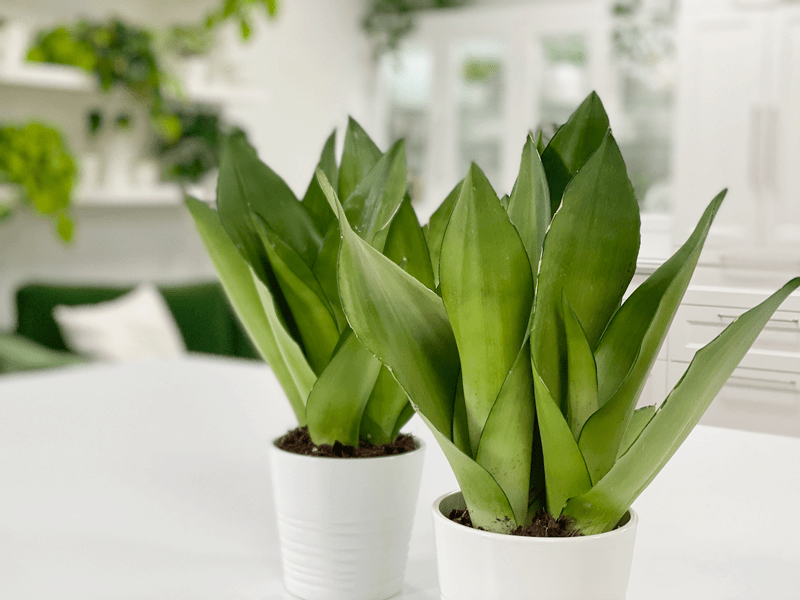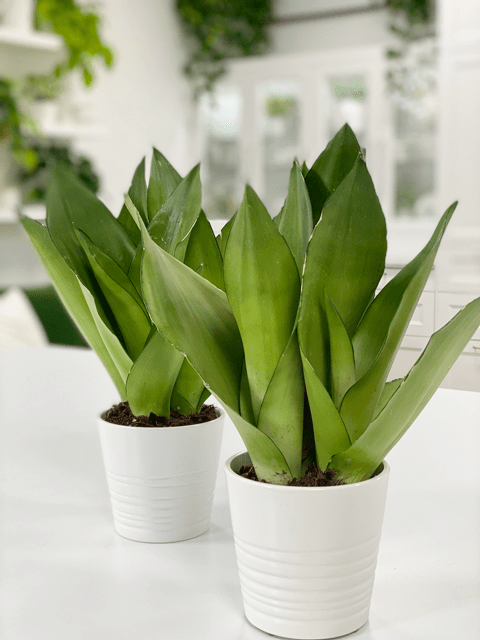

 Add to favorites
Add to favorites
Looking to add some visual interest to a room? Perhaps you want to create a depth of color amongst your plants? Well, the moonshine snake plant just might be what you are looking for. I love its pale sage-green color. It adds a wonderful contrast up against my other plants. I am also drawn to the flat, paddle-like blades.

I paid $19.99 for 2 of these plants from the Portland Costco store.
The moonshine version of snake plants only grows to roughly six to twelve inches tall, so they are a great plant to tuck in an empty spot. I am all about big plants, but I see the benefit of having some smaller ones to create staggered heights. When I decorate, with or without plants, I love to keep a visual flow throughout the space. It is one of the keys to making a space feel warm and welcoming.
If you work a lot, tend to travel for weeks at a time, or you are a busy parent, snake plants should be high on your list, since they don’t mind a little neglect. They are mildly poisonous if eaten (like most houseplants), so be sure to keep them away from reaching hands or sniffing puppies.
Easy does it with the watering. You want to be careful not to overdo it, because your plant will rot out. Always make sure the soil is almost completely dry before thoroughly watering again. Size and location depending, you will end up watering your snake plants every 2-6 weeks. If you travel or tend to ignore plants, this is the one for you. But don’t ignore them TOO long; nobody really likes to be ignored, whether human or plant.
Even though Sansevierias prefer medium light, they’ll also tolerate low light and high light. The main thing you need to watch for is DIRECT sunlight. No houseplant does well in those conditions because the leaves can burn. So, as you can see, this plant gives you many options when it comes to placement.
Sansevierias will tolerate a wide range of temperatures in our homes. They can hang out in temperatures ranging between 55 – 85 degrees (F). Temperatures below 55 degrees (F) can cause them harm.
Snake plants don’t need much fertilizer, but they will grow more if you fertilize them during their growing season in the spring and summer. Use a basic fertilizer for houseplants and only add it every few weeks or every other watering. I use a diluted form of organic Espoma Organic Indoor Plant Food on all my plants.
 Soil
SoilI use succulent and cactus mix combined with potting soil in a ratio of 1:1. Snake plants like quick-draining soil, but if the water runs straight through, the roots won’t have time to take up any water. Be sure to plant in a pot that has drainage holes, since snake plants don’t like a soggy bottom (like who does!).
Diagnosing what is going wrong with your plant is going to take a little detective work, but even more patience! First of all, don’t panic, and don’t throw a plant out prematurely. Take a few deep breaths and work down the list of possible issues.
Below, I am going to share some typical symptoms that can arise. When I start to spot troubling signs on a plant, I take the plant into a room with good lighting, pull out my magnifiers, and begin by thoroughly inspecting the plant.
If you want to have healthy houseplants, you MUST inspect them regularly. Every time I water a plant, I give it a quick look-over. Bugs/insects feeding on your plants reduces the plant sap and redirects nutrients from leaves. Snake plants are highly pest-resistant, but in poor conditions, they can get mealybugs and/or spider mites. The biggest threat is fungal growth due to root rot. If the plant receives too much water or grows in soil with poor drainage, the fungus may start to appear near the base of the plant.
While the toxicity levels are low, it’s safest to keep pets away from your plant. It can cause excessive salivation, pain, nausea, vomiting, and diarrhea.
Hi. May I ask?
My moonshines has wrinkles so I just gave them a lot of water. Will the wrinkles go away when the leaves re-hydrates or will they stay like scars? How long will it takes for the leaves to be back to normal appearance?
Good morning Rin,
Thanks for reaching out regarding your moonshine plant. They are one of my favorites amongst the snake plant family. I see small wrinkles in mine (nothing alarming) and they have always been there so it’s really hard to say if yours will go away. I have found that when I have to correct a snake a plant, it seems to take quite a bit of time for things to turn back around. For instance, I have a 5′ snake plant and found that the blades were curling inward. I finally got the nerve to repot it. The soil that it came to me in, was so compact that I couldn’t even poke my finger into it. I had to break the ceramic pot to get it off. I then found out that due to the compacting soil, the water wasn’t reaching the main roots. Shew. The blades haven’t corrected yet so we shall see in time.
I shared that little experience because you might want to look at the soil and roots to make sure they are taking up water. Unless, of course, the wrinkling happened due to neglect (and I say that kindly, we all have those moments). Anytime, I see one of my plants (regardless of the variety) struggle, I start by assessing the soil and roots and go from there.
How long have you had this plant? Did it accidentally go through a drought and this is when the wrinkling started? Moving forward, as already mentioned, I would double-check the soil and roots, be a bit more attentive to watering and take it from there. It’s hard to diagnose plants from afar and even up close at times. blessings, amie sue
Good morning Amie Sue,
Thank you very much for the advice. I’ll take note and see how they fares over time. I really hope they won’t die.
I bought my moonshines from the supermarket about 3-weeks ago. Few of the blades already has bits of wrinkles at the tips but nothing alarming. 2-weeks on, I re-potted 1 into a nicer pot. The soil are okay, easily divided, so I think soil is not the issue.
I may have not given them enough to drink (afraid of over-watering) particularly when it was such a hot 2nd week and they are out in the hot afternoon sun. That’s when I started to notice the wrinkles has spread from the tips to the base of the leaves, leaving me anxious.
Regards, Rin
Good evening Rin,
I would just suggest to give them time to acclimate to their new home. They have been through a lot. They were brought up in the perfect conditions in a nursery where they are get professional attention. From there, they go to a store, if it’s a supermarket, chances are that they don’t get the best attention and care so the plants go a bit into shock. Then they get moved again to your home… so be patient. :)
Let them dry out before watering. I take 90% of all my plants to the sink when I water them. I water until it comes out the drainage holes. Once the water stops dripping, it goes back into the cover pot until the next time. That way they don’t stand in water which can lead to root rot which is harder to fix and at times, unfixable. I guess that brings to mind to make sure that your plant pot that it is directly in has drainage holes.
Try not to stress throughout the process. Keep me posted if you feel like it. It’s always good to have plant support when trying to be a good plant-parent. :) blessings, amie sue
Hi Amie Sue,
I bought a 6inch moonshine three months ago. It grew beautifully and keeping in mind not to over water it, i watered it every 20 days or so making sure it was dry before and drain well after. I noticed it came in a very compact 3inch pot and I left it that way probably because succulents like to stay close. Then, I noticed wrinkles through the middle of all my four leaves and since yesterday also curling slightly inward. I read it was because of dehydration somewhere, but I am pretty sure I watered it without neglecting. I wanted this plant so badly to thrive because of my previous experience with mother-in-laws tongue. Then, I checked the roots are shooting up the surface of pot and water was away frm their reach. I repotted it into a 4 and half inch terracotta pot. And watered it thoroughly and the drain. I am hoping I did the right thing. I coincidentally kept to your post and found it helpful too. Please let me know your thoughts. Fingers crossed, it will survive. It stands on my kitchen counter which has a east facing patio glass door and windows around and gets a good morning light.
Thanks so much😊
Good morning Sameera,
It sounds like you have done everything correctly. Keep in mind that the water evaporates more quickly in a terracotta pot so you might need to water more often. I have a very large floor snake plant that I just repotted as well. The dirt was so compact I couldn’t even poke my finger into it. It took quite a while to get enough of the old soil away from it so the center could be reached with water. It’s also in an East facing winder. Crossing fingers that yours does well. I love the moonshine variety! blessings, amie sue
Thankyou so much Amie sue. I will reach you again for more questions. And by the way I love your website.
Good day!!
Thank you, Sameera for sharing that with me. It means a lot. I am always here. Enjoy your Moonshine! blessings, amie sue